


28 February 2023 Barcelona – In recent years, the issue of climate change has gathered momentum, with the frequency of persistent hot weather and climate-related natural disasters drawing worldwide attention to the urgent need for action.
OPPO believes that better environmental protection can only be achieved through the parallel advancement of science and technology. Following years of research and analysis, OPPO released the OPPO Climate Action Report: Climate Pledges and Low Carbon Development Strategy, at MWC 2023. In the report, OPPO pledges for the first time to achieve carbon neutrality across its global operations by 2050. With technical support from global consultancy Deloitte1, the report outlines five key areas in which OPPO will work towards achieving this goal: low-carbon manufacturing, reducing the carbon footprint of products, investing in options that generate less carbon, utilizing digital technology to manage carbon emissions, and collaborating on industry standards to address climate change.
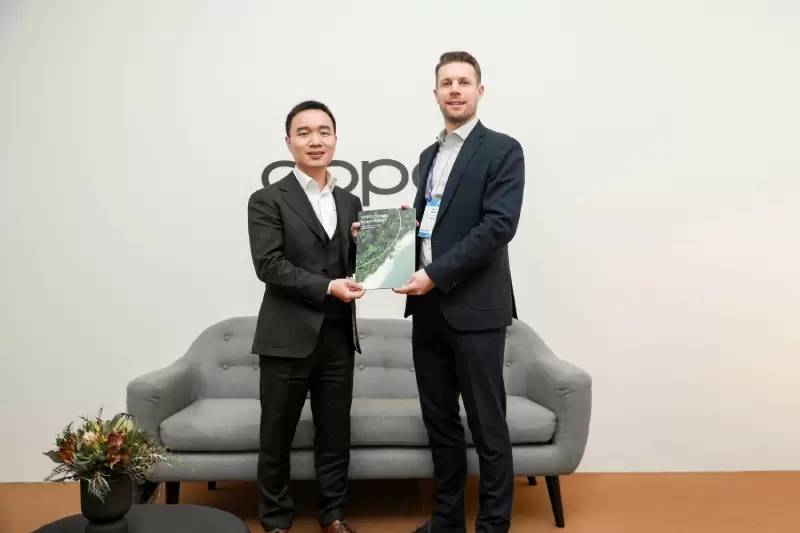
Billy Zhang, Associate Vice President and President of Overseas Sales and Service at OPPO, releases the OPPO Climate Action Report on the first day of MWC, with congratulations from Steven Moore, Head of GSMA Climate Action
Starting in 2020, OPPO has published a sustainability report each year to publicly disclose its plans and practical progress towards sustainability goals. In 2022, OPPO completed its first global inventory of greenhouse gas emissions and used this data as the scientific basis for its carbon reduction strategy. Now, in the new Climate Action Report, OPPO pledges to make its operations carbon neutral by 2050.
Commenting on this commitment, Tony Chen, OPPO Founder and CEO, said: “Achieving our goal of becoming carbon neutral will require both determination and patience. Guided by our mission of ‘Technology for Mankind, Kindness for the World’, we promise to pursue carbon neutrality with the same zeal and commitment that we invest in our technological innovation.”
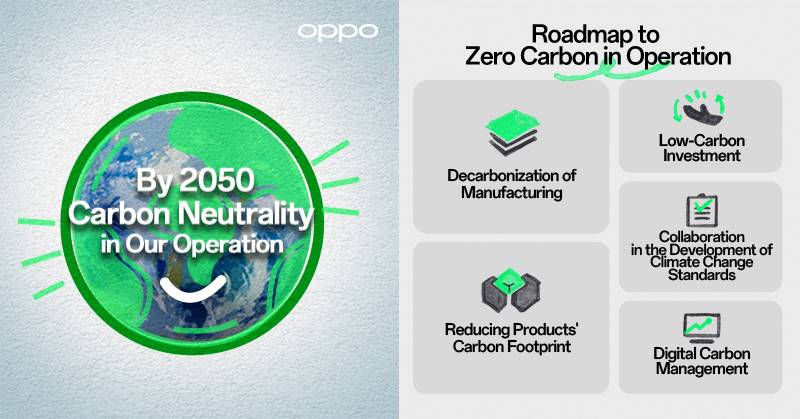
OPPO pledges to become carbon neutral across its global operations by 2050 and identifies low carbon development roadmap
Promoting green manufacturing and
operations through innovation
OPPO has held onto its global position as the fourth-largest phone manufacturer for two consecutive years,with users in over 60 countries and regions worldwide. As its business grows rapidly, OPPO is equally concerned about how to reduce its environmental impact.
Among the carbon emissions generated by OPPO's various operations, factories and data centers are the two most significant sources of greenhouse gas emissions, accounting for 62% and 31.9% respectively. While continuing to drive commercial growth, OPPO is also exploring innovative ways to achieve greener manufacturing and business operations. Through energy saving and emission reduction initiatives, by the end of 2022, OPPO has managed to reduce 6000 tons of greenhouse gas emission from its operation each year. This is equivalent to the amount of greenhouse gas absorbed by 3,330 square kilometers of forest in a year.
Since 2020, OPPO has systematically carried out a series of energy-saving upgrades to key machinery in its factories. One such project has involved automating previously manually operated machines. Compared with manual control, the automated equipment can be set to operate precisely according to the real-time requirement, thus reducing power consumption to the bare minimum. For example, with the automation upgrades introduced to the corner cutting machines, power consumption has fallen by 54%.
In addition, OPPO is also working on the construction of carbon neutral data centers. Its first self-built data center, OPPO Binhai Bay Data Centre not only uses 100% renewable energy, but also continues to explore and apply cutting-edge, low-carbon technology. One of the key outcomes of this exploration has been the research and implementation of immersion cooling technology for GPU server clusters.
We are living in a digital era, with ever-increasing demand for data storage, artificial intelligence, and high-performance computing. Thus, the power consumption of data centers and their GPU server clusters is also rising significantly. Not only does this increased power consumption present a major challenge, but we must also work out how to dissipate the heat produced as efficiently as possible. Most traditional data centers rely on mechanical equipment such as fans and air conditioners to cool the building, which in turn consumes more energy and produces higher levels of CO2.
In order to improve energy efficiency and reduce carbon emissions, OPPO is deploying immersion cooling technology for GPU server clusters in its data center. Immersion cooling technology, which refers to the direct immersion of servers in a non-conductive liquid, directly draws the heat generated during operation away through the liquid, without the need for active cooling by devices such as fans and air conditioners. The liquid that has risen in temperature is cooled by circulation and then returned to continue absorbing thermal energy. The heat recovered is then put to good use in other areas such as heating and hot water provision, significantly improving the energy efficiency of the overall system. The deployment of immersion cooling technology leads to a 45% improvement in energy efficiency, and an industry-leading data center power usage efficiency (PUE) as low as 1.15.
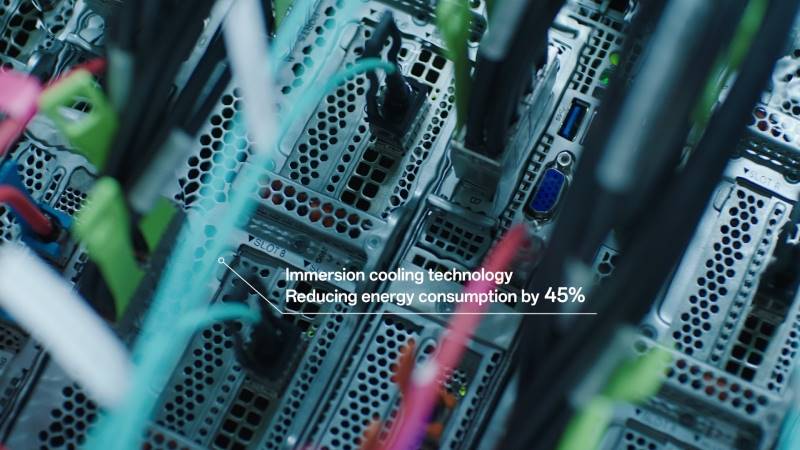
OPPO Binhai Bay Data Center deploys
immersion cooling for GPU server clusters
Introducing sustainability into the product
management life cycle
While constantly thinking about how to improve the user experience of its products, OPPO also aims to provide greener products. To this end, OPPO has made sustainability a key goal in the life cycle management of its products to minimize their impact on the environment.
While designing the packaging of its products, OPPO follows the internationally recognized green packaging principle of 3R+1D (reduce, reuse, recycle and degradable). In 2023, starting in the European market, nearly all plastics have been removed from the packaging of OPPO’s smartphones, making it 100% biodegradable and more eco-friendly. Approximately 45% is also made from recycled fibers, sourced from recycled wastepaper or plant-based materials (such as sugarcane and bamboo byproducts), helping to reduce the demand for raw materials.
OPPO has also made technological breakthroughs aimed at improving the durability of its products. For example, OPPO's proprietary Battery Health Engine technology can maintain 80% of the original battery capacity for up to 1600 charging cycles, significantly extending battery life.
The volume of electronic waste generated globally has grown by 21% over the past 5 years, making it the fastest growing category of household waste2. To tackle the problem of e-waste pollution, OPPO has established a number of product recycling systems and launched a trade-in service in both domestic and international markets to promote the recycling of used electronic devices. In 2021, 1.2 million phones were recycled in China, amounting to a total weight of 216 tons. This number rose to 1.3 million phones and 240 tons in 2022. In the EU and other regions, OPPO is involved in the Green Dot program as well as partnering with professional recycling firms to help recycle used products.
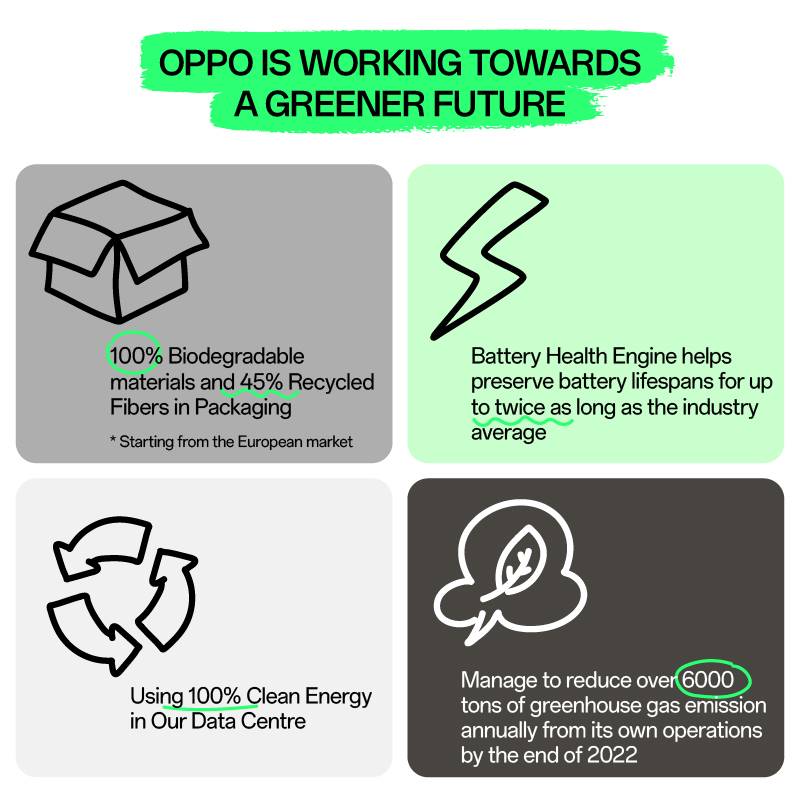
OPPO’s progress towards low carbon development
For a long time, OPPO has not only been investing in low carbon initiatives but has also taken action to inspire more of its peers. During the Global Mobile (GLOMO) Awards at MWC 2023, OPPO Senior Vice President and Chief Technology Officer, Jun Liu, was invited to present the Tech4Good award, recognizing companies that have used technology and innovation to make the world better and to solve global challenges. In recognition of its own efforts, OPPO was also invited to join the judging panels for the Best Mobile Innovation for Climate Action Award and the Outstanding Mobile Contribution to the United Nations Sustainable Development Goals Award.
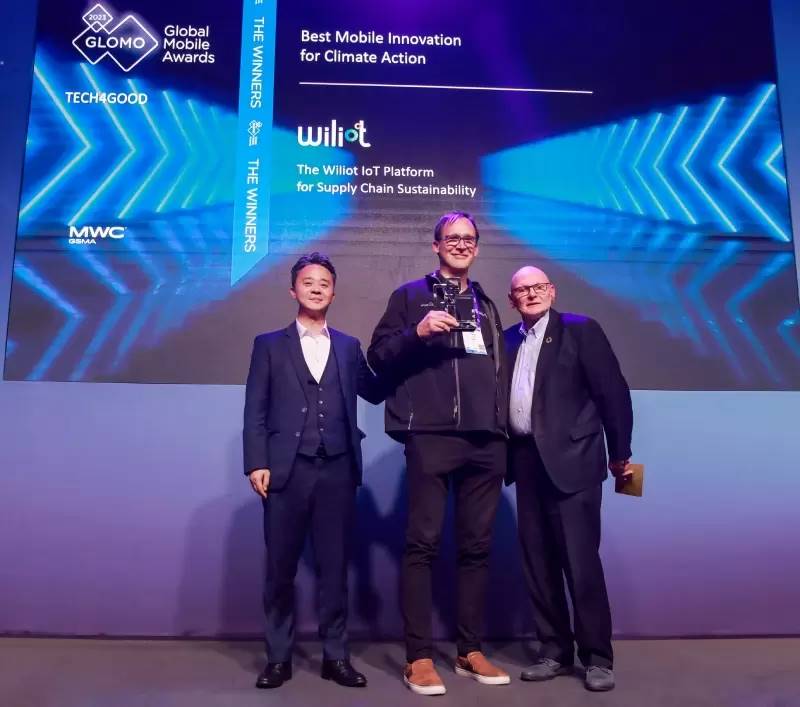
Jun Liu, Senior Vice President and Chief Technology Officer at OPPO, presents the 2023 GLOMO Tech4Good Award to winners
The road to a greener future is a long one, but with its Climate Action Report and low carbon development strategy, OPPO is already well on the way to achieving this goal. OPPO is committed to playing its part as it works with both partners and the public to build a better future for all.
To learn more about OPPO’s low carbon development strategy, please refer to the OPPO Climate Action Report:https://www.oppo.com/content/dam/oppo/common/mkt/footer/OPPO-Climate-Action-Report-EN.pdf
近年来气候变化问题引发越来越多的关注,频频出现的持续高温天气和气候灾害让我们不得不思考,人类在自身发展的同时,如何更好地与自然和谐共处?
OPPO一直相信,科技进步与生态环境保护是相辅相成的。经过多年的思考与积累,在2023年巴塞罗那世界移动大会(MWC 2023)上,《OPPO低碳发展白皮书》正式发布,第一次做出了 OPPO将于2050年实现自身运营碳中和的承诺。白皮书由德勤提供技术支持全面展示了OPPO未来将不断在低碳生产、低碳产品、低碳投资、低碳数字化、以及参与制定低碳标准五个方面持续投入的低碳发展战略。
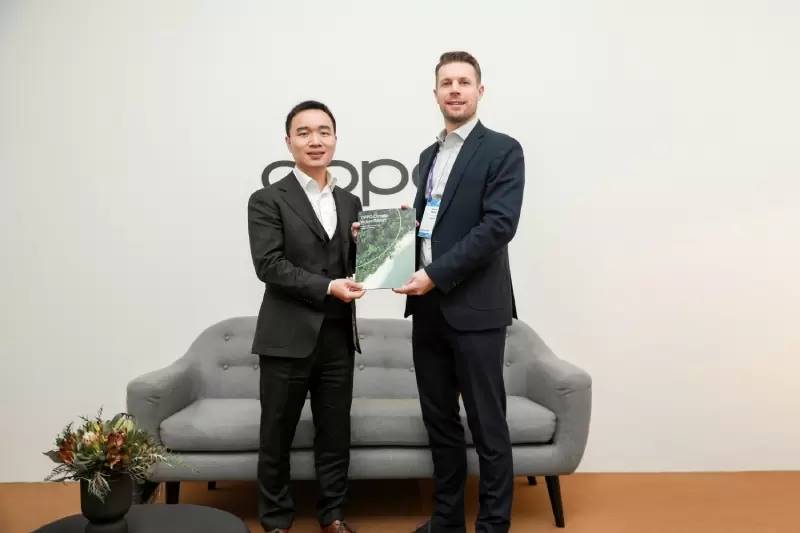
OPPO海外销售与服务总裁张洲川在MWC首日发布《OPPO低碳发展白皮书》,GSMA气候行动负责人Steven Moore 现场致辞表示祝贺。
从2020年起每年发布可持续发展报告,向社会公众披露企业在可持续发展方面的规划与进展,到2022年首次完成全球范围内自身运营产生的温室气体排放盘查,并以此为数据基础科学规划减碳战略,再到今年提出2050年实现自身运营碳中和的承诺,OPPO对低碳发展的思考和实践也逐步深入。
对于这份承诺,OPPO创始人兼首席执行官陈明永谈道:“碳中和目标的实现,需要决心,也需要耐心。我们承诺,在‘科技为人,以善天下’的使命牵引下,OPPO会像坚定投入科技创新一样,咬定青山,为碳中和进程贡献力量。”
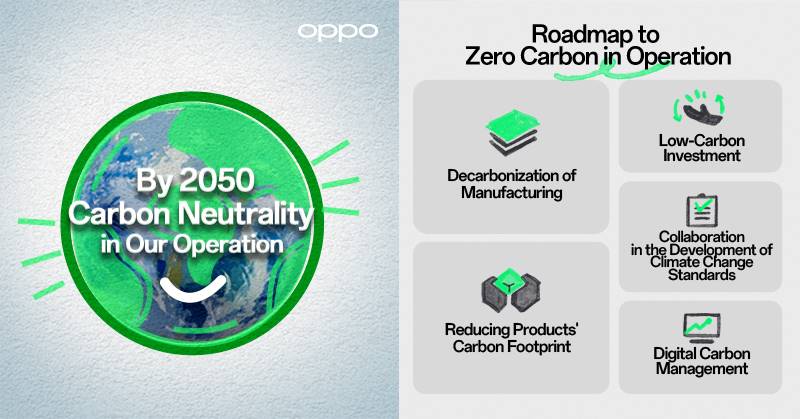
OPPO承诺2050年实现自身运营碳中和
并制定低碳发展路径

当前,OPPO业务遍布全球60多个国家和地区,连续两年稳居全球第四大手机厂商,在业务快速增长的同时,OPPO也在思考如何降低生产运营带来的环境影响。在OPPO自身运营产生的碳排中,全球工厂和数据中心是最主要的两大温室气体排放来源,分别占比62%和31.9%。在保障业务发展的同时,OPPO也在持续探索以技术创新的方式,实现更绿色的生产运营。通过技术创新推动节能减排,截至2022年底,OPPO已投产的节能减排项目每年可实现自身运营范围内超过6,000吨的温室气体减排量,相当于3330平方公里森林一年吸收的温室气体量。
自2020年开始,OPPO针对工厂的重点生产设备开展了一系列节能改造工作。以工厂车间设备自动化升级项目为例,针对传统人工调控的生产设备无法依据实际情况精准调整运行状态而导致电量浪费的情况,OPPO通过提升设备的自动化水平实现节能改造,从而降低生产环节的能耗。例如,通过对切角机设备的自动化升级,实现了54%的电耗下降。
此外,OPPO还积极推进零碳数据中心的建设。作为首个自建超大型数据中心,OPPO智能云(大湾区)数据中心不仅100%使用可再生能源,也持续探索行业最前沿的低碳技术创新和应用。其中,研究和部署浸没液冷技术的GPU服务器集群是一项重要的探索成果。
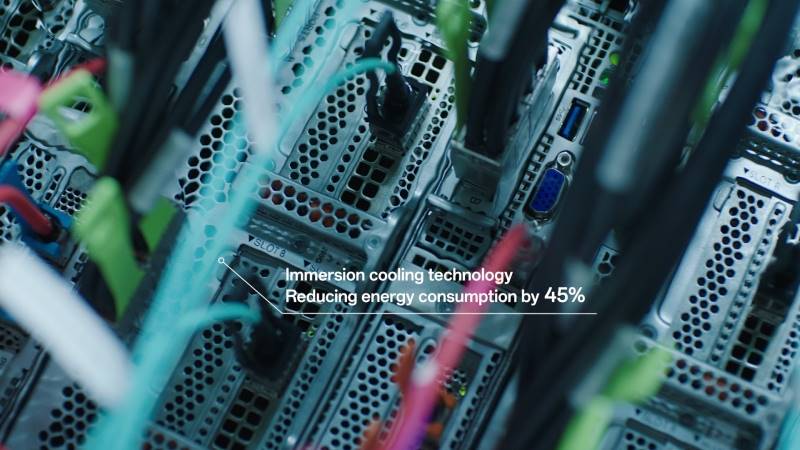
OPPO滨海湾数据中心部署浸没液冷GPU集群
随着数字时代的发展,数据存储、人工智能计算的需求也日益提升。为此,服务器集群的功耗也不断提升。这不仅需要更多电力,如何有效散热也是一个重大挑战。传统的数据中心主要依靠风扇、空调等机械设备进行制冷散热,这又产生了更多的能耗和碳排。为了提升能源利用效率,降低碳排,OPPO积极研究和部署浸没式液冷GPU服务器集群。浸没液冷技术,是指将服务器直接浸泡在不导电的液体中,直接将运转过程中产生的的热能传导给液体,不需要风扇、空调等主动式冷却的机械设备。温度上升的液体通过循环冷却的方式,再回流继续吸收热能,回收的热能还能继续用于供暖、生活热水提供等场景,极大地提高了能源的利用效率。浸没液冷设备的节能尝试初见成效,节能效果提升了45%,数据中心电源使用效率(PUE)低至1.15,处于行业领先水平。

在不断思考如何给用户带来更极致的产品体验的同时,OPPO也希望用户能切实地使用上更绿色的产品。为此,OPPO把可持续发展理念融入产品全生命周期管理,最大程度降低对环境的影响。
在产品包装材料的选择上,OPPO依照国际绿色包装3R+1D为设计原则,在包装设计中使包装减量化、可回收、可循环、可降解。2023年从欧洲市场开始,OPPO手机彩盒塑料包装几乎完全清除,实现手机产品包装100%可自然降解,并在彩盒中使用了45%的再生纤维材料,这些材料来自被回收的废纸或植物,如竹子和甘蔗的残渣,通过资源重复利用减少原材料的消耗。
为了延长产品的生命周期,OPPO也在技术上实现了很多新突破。例如,OPPO自研的电池健康引擎技术,最高能达到循环充放1600次后电池容量仍能保持80%的剩余容量,两倍于行业标准,大幅提升电池使用寿命。
全球电子废弃物在过去5年内增长21%,是全球增长最快的家庭垃圾,为应对电子垃圾污染的问题,OPPO建立了完整的一套产品回收体系,在国内外市场开展以旧换新业务,推动旧手机的回收和再利用。2021年,国内市场手机回收量达到120万台,回收产品重量达216吨。2022年,旧手机回收业务持续增长,国内市场手机回收量达到130万台,回收产品重量达240吨。在欧盟和其他地区,OPPO废弃包装的“绿点”回收体系,与专业的第三方回收公司进行合作进行电子垃圾回收。
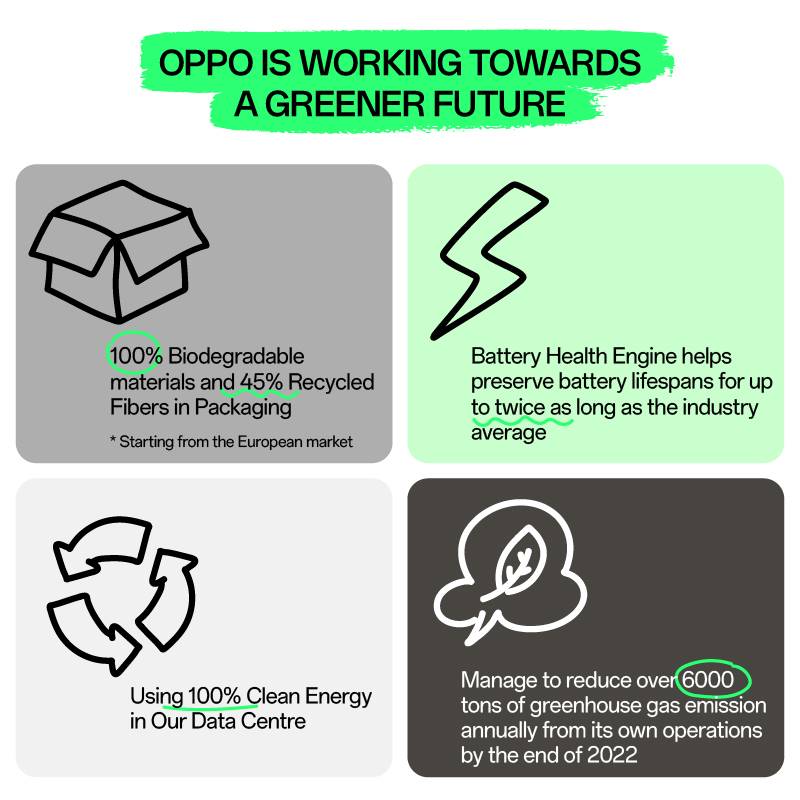
OPPO低碳发展进程
长期以来,OPPO不仅自身在绿色低碳方面持续投入,也正以实际行动影响更多同行者。巴展期间,OPPO受邀出席MWC 2023全球移动大奖(GLOMO Awards)颁奖典礼,并由OPPO高级副总裁、首席技术官刘君作为颁奖嘉宾,为Tech4Good类别获奖者颁奖,让更多人看到那些使用技术和创新改善人们生活、解决全球性问题的先行者。今年,OPPO受邀作为行业评委,对其中的 “最佳促进气候行动移动创新奖”(Best Mobile Innovation for Climate Action)和“联合国可持续发展目标杰出移动贡献奖”(Outstanding Mobile Contribution to the UN SDGs)两个类别的案例进行评审。

OPPO高级副总裁、首席技术官刘君
出席2023全球移动大奖(GLOMO
Awards)
颁奖典礼,并为获奖者颁奖
这条“绿色之路”还很长,但OPPO已经启程。OPPO将以“绿色低碳”理念为指引,继续推进绿色生产运营,为用户带来更多环境友好的产品,向更绿色低碳的未来继续前行。
了解更多关于OPPO低碳发展的信息,欢迎点击查阅《OPPO低碳发展白皮书》:https://www.oppo.com/content/dam/oppo/common/mkt/footer/OPPO-Climate-Action-Report-CN.pdf
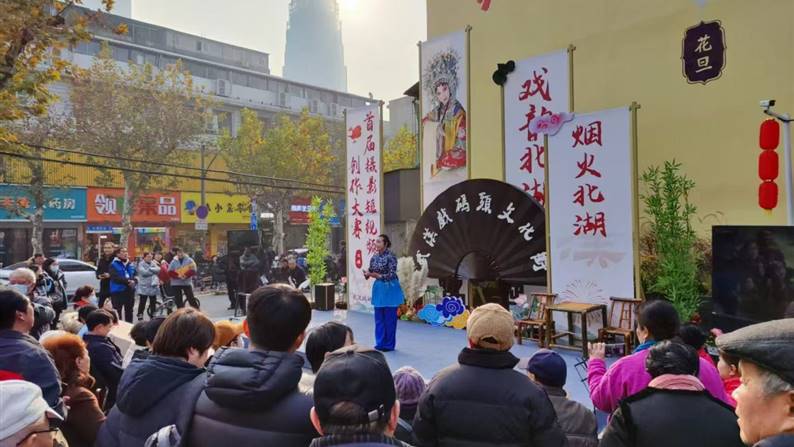
打造绿色低碳街区,奏响幸福美好生活最强音
10-18 · 来源:湖北省武汉市江汉区北湖街道环保社区 · 作者:湖北省武汉市江汉区北湖街道环保社区
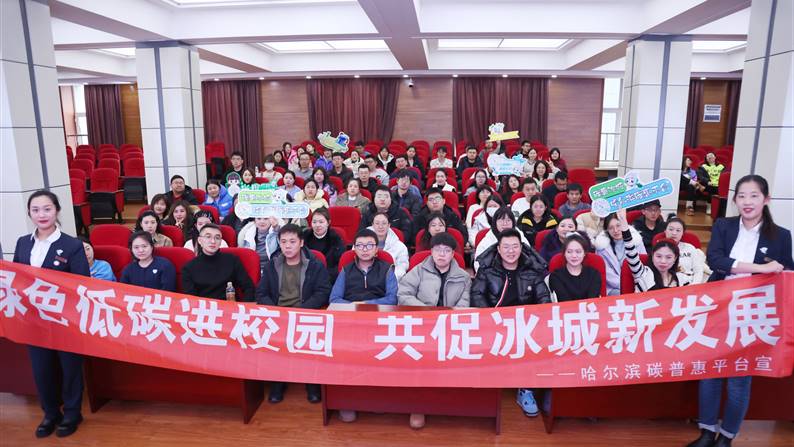
“碳惠冰城”:东北首个市级平台的“双碳”实践与冰城示范
10-15 · 来源:哈尔滨产权交易所有限责任公司 · 作者:哈尔滨产权交易所有限责任公司
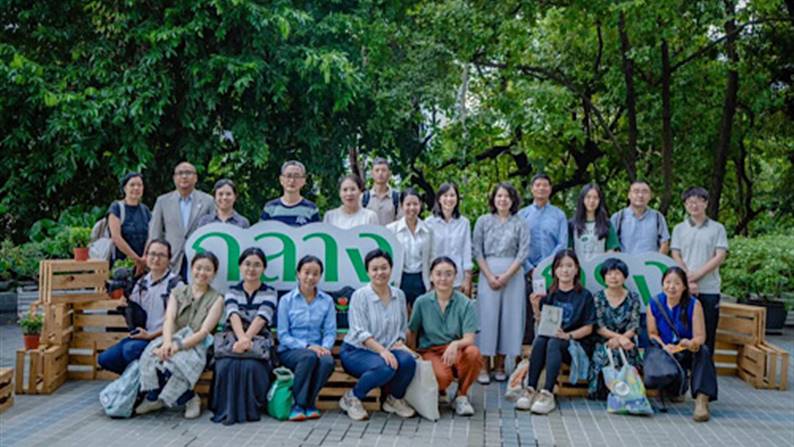
亚洲气候治理新篇章:中国公益代表团参访曼谷气候周,探索跨区域合作新路径
10-10 · 来源:公益时报 · 作者:公益时报